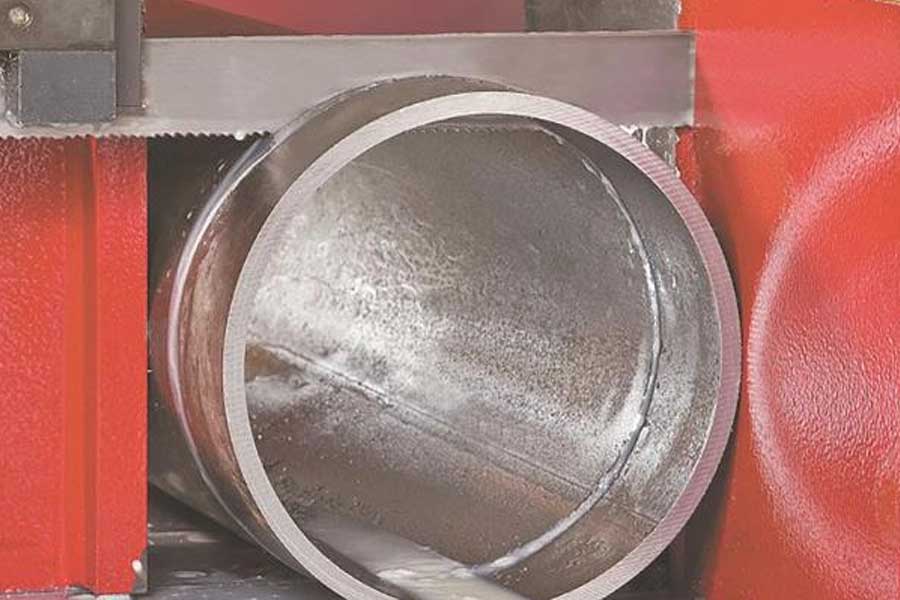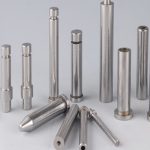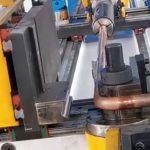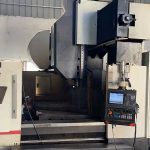Through a comprehensive understanding of sawing mechanics and the specific problems that arise when sawing tubular workpieces, many problems in pipe and pipe cutting can be solved. Eliminating sawing problems helps in three areas: increasing the cutting rate, extending the life of the saw blade, and optimizing cutting quality.
When cutting hollow workpieces, the blade will interrupt the cutting. It enters and leaves one side of the material, and then enters and leaves the other side. This puts extra force and stress on each tooth compared to cutting a solid workpiece. When one saw tooth touches the cutting tooth and the next saw tooth enters the cutting tooth, the force is so great that it actually breaks a saw tooth. After the stress causes the serrations to chip or completely tear the serrations, the force on the remaining serrations will be even greater, which may cause premature failure of the blade.
The circular workpiece poses a challenge in terms of coolant distribution. The shape of the workpiece will divert the coolant from the cutting, which can cause inaccurate cutting and increase heat build-up. Both of these problems will destroy the jagged edges prematurely.

Many traditional bimetal blades also produce a heat-affected zone (HAZ), where the heat increases so much that it changes the characteristics of the steel. Cutting through the heat-affected zone will cause the serrations to tear off the blade. Likewise, if the speed of the blade is too low for the material, the process cannot provide enough penetration for each tooth, causing more friction than cutting. This can also overheat the material.
Another challenge is the incorrect blade spacing, which is the number of teeth per inch. The number of teeth in contact with the workpiece will affect the performance and durability of the saw blade. Too few teeth in contact with work will cause early tooth loss; too many teeth will reduce the speed of the blade and ultimately make the material unable to cut.
A saw blade with a constant pitch will increase harmonic vibration, which can lead to excessive noise, undesirable saw blade or saw blade vibration, and even in severe cases, it can cause cuts. Manufacturers can solve this problem by choosing variable pitch blades, which can greatly reduce harmonic vibration. The change in tooth pitch disrupts the rhythm that causes harmonics and improves chip removal.
Although each band saw blade looks somewhat similar, they are quite different. Blade manufacturers have proposed new concepts in their construction and have incorporated new features over time, allowing the blades to cut faster and have a longer service life.
In the past few decades, the band saw blade is likely to be a single steel strip with serrated teeth, but today, advanced saw blades are more likely to be made of multiple parts. An example is a blade made by a patented process in which two high-speed steel wires are connected to the backing steel. The heat used in the connection process of solid-state diffusion bonding is about 20% of the conventional welding process, which is 170% larger than the welding contact area produced by the conventional process. The result is that the possibility of fracture and cracking at the interface of the two materials is greatly reduced.
Soon after the first use, the blade made by this method formed a 0.001 to 0.002 inch deep U-shaped groove between the two high-speed steel edges. The cutting action of the serrated geometry produces two chips. Compared with traditional chips, the two chips are easier to remove, so the possibility of welding to the saw teeth is less. The groove also allows increased coolant flow to the cutting surface. The proper coolant flow can cool and lubricate the blades and flush away the chips.
Troubleshooting guide
1. The blade is broken:
Wrong blade selected-choose a blade with the right pitch for the application.
Saw blade tension setting is incorrect-adjust the saw blade tension according to the saw manufacturer’s instructions.
The feed pressure is set too high-reduce the pressure accordingly.
Insufficient lubrication-confirm that the lubricant is matched to the application and mixed in the proper ratio. If necessary, adjust the lubricant nozzle to improve the lubricant flow.
The pressure block is set too tight-adjust the guide.
The blade rubs on the rim-adjust the center of the wheel.
Insufficient blade holder-tighten, align, adjust or replace the guide plate.
The side guides are set too tightly-adjust the side guides.
2. Premature wear of saw teeth:
Install the blade backwards-install the blade correctly.
Incorrect blade insertion procedure-use the insertion procedure recommended by the blade manufacturer.
The material is too hard or the surface scales are too thick-choose a blade suitable for the material.
The material is too hard-increase the feed pressure.
Insufficient lubrication-confirm that the lubricant is matched to the application and mixed in the proper ratio. If necessary, adjust the lubricant nozzle to improve the lubricant flow.
The blade speed or feed pressure is set too high-adjust the setting according to the manufacturer’s recommendations.
3. Serrated cutting:
Insufficient blade holder-tighten, align, adjust or replace the guide plate.
Worn blade-replace the blade.
Incorrect feed pressure setting-adjust according to manufacturer’s recommendations.
The tooth pitch in the application is incorrect-choose a blade that meets the blade manufacturer’s recommendations.
Insufficient lubrication-confirm that the lubricant is matched to the application and mixed in the proper ratio. If necessary, adjust the lubricant nozzle to improve the lubricant flow.
Insufficient blade holder-tighten, align, adjust or replace the guide plate.
4. Wandering and cutting:
The feed pressure is set too high-adjust according to the manufacturer’s recommendations.
Blade tension is too low-increase the tension as recommended by the manufacturer.
Damaged serrations-replace the blade and confirm that it matches the hardness of the material.
Insufficient blade holder-tighten, align, adjust or replace the guide plate.
Chips accumulate in the blade teeth
Worn or missing bristles-adjust or replace.
Insufficient lubrication-confirm that the lubricant is matched to the application and mixed in the proper ratio. If necessary, adjust the lubricant nozzle to improve the lubricant flow.
The blade speed or feed pressure is set too high-adjust the setting according to the blade manufacturer’s recommendations.
Wrong blade selected-choose a blade with the right pitch for the application.
5. The blade is only worn on one side:
Worn wheel flange-adjust or replace the wheel.
Worn or misaligned blade guide-adjust or replace.
The tooth is chipped and embedded in the workpiece-replace the blade and use the run-in procedure recommended by the blade manufacturer.
6. Broken tooth:
Incorrect blade insertion procedure-use the insertion procedure recommended by the blade manufacturer.
The blade speed is set too low-adjust the speed according to the manufacturer’s recommendations.
The feed pressure setting is too high-adjust the setting according to the manufacturer’s recommendations.
The incisor is stuck-increase the blade speed and reduce the feed pressure.
Insufficient lubrication-confirm that the lubricant is matched to the application and mixed in the proper ratio. If necessary, adjust the lubricant nozzle to improve the lubricant flow.
The material is too hard or the surface scales are too thick-choose a blade suitable for the material.
Wrong blade selected-choose a blade with the right pitch for the application.
Workpiece rotation-tighten the vise, if you want to cut the bale, use the bale clamp.
7. Worn or damaged blade backing:
The preload of the spare rail is too large-adjust the pressure block according to the manufacturer’s recommendations.
Saw blade tension setting is incorrect-adjust the saw blade tension according to the saw manufacturer’s instructions.
Worn blade-replace the blade.
The blade speed or feed pressure is set too high-adjust the setting according to the blade manufacturer’s recommendations.
8. Distorted cutting edge:
The feed pressure is set too high, causing the saw blade to stick-adjust the pressure according to the saw manufacturer’s instructions.
Insufficient blade holder-tighten, align, adjust or replace the guide plate.
Workpiece is not aligned-tighten the vise.
Finally, saw operators should rely on their own cutting experience to prevent small saw problems from turning into big saw problems. In addition to finding clues, listening to clues can also be of great help. If the cut sounds incorrect, there is a problem, and troubleshooting should begin as soon as possible, not later.
Link to this article: Troubleshoot the sawing problem as follows
Reprint Statement: If there are no special instructions, all articles on this site are original. Please indicate the source for reprinting:https://www.cncmachiningptj.com/,thanks!
 3, 4 and 5-axis precision CNC machining services for aluminum machining, beryllium, carbon steel, magnesium, titanium machining, Inconel, platinum, superalloy, acetal, polycarbonate, fiberglass, graphite and wood. Capable of machining parts up to 98 in. turning dia. and +/-0.001 in. straightness tolerance. Processes include milling, turning, drilling, boring, threading, tapping, forming, knurling, counterboring, countersinking, reaming and laser cutting. Secondary services such as assembly, centerless grinding, heat treating, plating and welding. Prototype and low to high volume production offered with maximum 50,000 units. Suitable for fluid power, pneumatics, hydraulics and valve applications. Serves the aerospace, aircraft, military, medical and defense industries.PTJ will strategize with you to provide the most cost-effective services to help you reach your target,Welcome to Contact us ( [email protected] ) directly for your new project.
3, 4 and 5-axis precision CNC machining services for aluminum machining, beryllium, carbon steel, magnesium, titanium machining, Inconel, platinum, superalloy, acetal, polycarbonate, fiberglass, graphite and wood. Capable of machining parts up to 98 in. turning dia. and +/-0.001 in. straightness tolerance. Processes include milling, turning, drilling, boring, threading, tapping, forming, knurling, counterboring, countersinking, reaming and laser cutting. Secondary services such as assembly, centerless grinding, heat treating, plating and welding. Prototype and low to high volume production offered with maximum 50,000 units. Suitable for fluid power, pneumatics, hydraulics and valve applications. Serves the aerospace, aircraft, military, medical and defense industries.PTJ will strategize with you to provide the most cost-effective services to help you reach your target,Welcome to Contact us ( [email protected] ) directly for your new project.
Link to this article:Troubleshoot The Sawing Problem As Follows
Reprint Statement: If there are no special instructions, all articles on this site are original. Please indicate the source for reprinting:Alloy Wiki,thanks!^^







